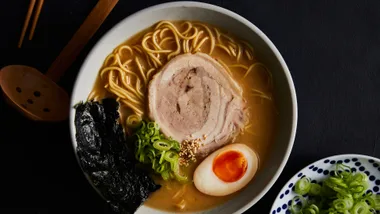The 22-course omakase menu by executive chef Chase Kojima and sushi chef Takashi Sano at Pyrmont’s Sokyo is booked out until the end of the year, thanks to the unparalleled quality of the sushi.
You’re not going to become a sushi master overnight – it’s a skill chefs perfect over years of training and practise – but by following these simple steps, you can learn and appreciate the art of nigiri at home.
First, always choose sustainable seafood – the quality and texture is key. The secret to good sushi rice is the vinegar – Kojima recommends using Shiragiku rice vinegar. From here, moulding the rice and artfully placing the seafood is a lesson in balance. “You want to make sure the protein and the rice eat well together,” says Kojima.
Recipe by Chase Kojima, words by Jordan Kretchmer.
What you’ll need
A good rice cooker is the simplest way to ensure your rice is cooked evenly.
And make sure to wash your rice – Kojima recommends washing it five times. “I also like to soak it,” he says. “When there’s a lot of water in the rice, it tastes better.”
Watch: Chase Kojima on tennis, Leonardo DiCaprio, and being a cat in the kitchen.
Step 1: cooking the rice
For sushi rice, rinse 650gm sushi rice in cold water at least 5 times until water runs clear, then soak in fresh water for 30 minutes. Place rice in a sieve and leave to drain at room temperature for 30 minutes. Cook rice in a rice cooker with 650ml water (use slightly less for firmer rice), then leave in rice cooker on warm to steam for 15 minutes. (Alternatively, cook rice using absorption method.)

Step 1: Wash the sushi rice at least 5 times in cold water.
(Photo: Will Horner)Step 2
Meanwhile, blend 90ml rice vinegar, 1 tbsp caster sugar and 1 tbsp salt in a blender until dissolved (4-5 minutes).
Step 3
Transfer warm rice onto a hangiri (special rice dish, or use a large plastic tray), pour over sushi vinegar and, with a rice paddle or large wooden spoon, use a cutting motion to mix vinegar through rice evenly. Don’t overmix or rice will become sticky from the starch.
Step 4: the nikiri soy
For nikiri soy, combine 150ml soy sauce, a small piece of kombu kelp and 150ml water in a saucepan and bring to a gentle boil over medium heat. Add 15gm katsuobushi (bonito flakes) and simmer until infused (4-5 minutes). Cool, then strain.
Note: Kombu and katsuobushi are available from Asian grocers and supermarkets.
Step 5: prepare the seafood
To prepare the seafood (we’ve used NZ King salmon, mackerel, snapper and cooked farmed prawns), cut fish using a sharp knife against the grain into 6mm-thick slices, and butterfly the prawns. Wrap seafood and refrigerate until chilled (5 minutes).

Step 5: Using a sharp knife, slice the fish into 6mm-thick slices.
(Photo: Will Horner)Step 6: shape the nigiri suhsi
Use moist hands (you can also use the pickling liquid from the ginger), and take 1 heaped tbsp rice, then press and turn in your palm, using your index and middle finger to mould the rice into an oval shape (see note below).
Take a piece of seafood and dot with a little wasabi. Place wasabi-side down on a portion of rice and lightly press to shape.
Serve nigiri sushi with pickled ginger, wasabi and nikiri soy on the side.
“The most important thing to consider is what type of seafood you’re going to be using,” says Kojima. “If you’re doing nigiri with a firmer protein such as prawns, you’ll want to form the sushi rice so it’s firmer. You’ll want to roll and mould the rice four to five times. For something like sea urchin, you want the rice to be super-soft, so that the rice mimics the protein. The nigiri’s texture has to be light but firm at the same time – it can’t fall apart. Once you get used to the feel of the rice, it gets easier.”

Step 6: Mould the rice into an oval shape.
 Will Horner
Will Horner
.jpg?resize=380%2C285)
